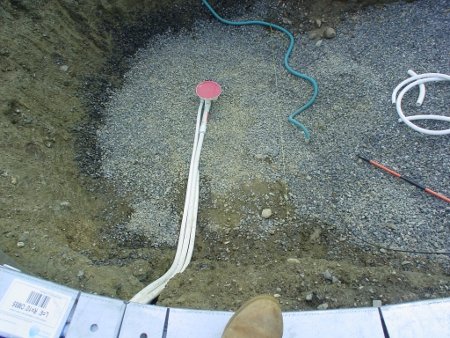The first thing a pool builder must learn when building in-ground swimming pools is how to handle a high water table. A pool’s finished height in the yard should not be compromised by a high water table. The builder must gain control of the ground water during construction until the pool is finally filled. An under drain must be installed underneath the pool’s rough construction. This would consist of a 1 ½” pvc line buried in ¾” stone at least 18” below the final desired depth of the pool. A reputable builder will leave the homeowner a way to access an under drain for future use when draining the pool is required.
When we install an in ground swimming pool in an area that has a high water table we must get control of the water at a level 1’ below where we are working. To do this you must determine how much water you are dealing with and how deep into the water table you will be working. To completely control the ground water in a pool dig you must have ¾” stone banked as high as the water table. The object is not to stop the water it is to control where it goes. When the ground water runs into the hole it hits the stone and falls to the bottom of the excavation. At least 18” below the finished surface we install an under drain beneath the pool. This line will run underneath the entire pool to the surface of the yard where a self priming pool pump will be hooked up to the end and pump the water from beneath the pool. We will use between 15-30 yards of ¾’ crushed stone in a pool dig with a high water table. The material you are digging in will determine how much stone you will need. If the soil is tight like clay then you will not need as much stone to dewater the hole. The tighter the soil the less it will clog the stone as the ground water runs through it. If the soil is loose and sandy then much more stone will be needed to control the water. The looser the soil the more fines in the material will clog the stone. Therefore you will need more stone to keep control of the water.
In 21 years of installing pools I have never run across a site where we could not control the water. Now, having said that, not every area we have installed these pools was a great idea. One thing to consider when installing a pool in a high water table is to adjust the bottom of the pool not the height of the pool. You are installing an “in ground pool” not an above ground pool or an ant hill . Either bring the finished depth up out of the water table by making the pool 6’ deep instead of 8’ deep, or adjust the interior slopes with in the pool so they are more gradual and allowing you to bank the stone higher. You will have to abandon a diving board when opting for either of these two options.
Sometimes the hassle of being deep into the water table is not worth going for a diving pool. I know, I own one of these pools. While digging my own swimming pool we were digging in all sand and 4’ deep into the water table. If you have ever been to the beach and dug a hole down by the water you will know how hard it is to dig a deep hole in the sand with the water rushing in. In my case I could only get 7’ of depth before the water and cave- ins were unbearable. Not enough water depth for a diving board but plenty of depth for the 360 degree slide we have running into the deep end. It took my three children about as long as it took to climb the ladder on the slide to get over the fact we were not going to have a diving board. Don’t be afraid of the ground water just get control of it. Be practical about how deep you want to go into the ground water. Believe it or not we hit ground water on at least 40% of all the pools we build in our area of New England.



Comments are closed.